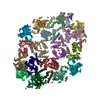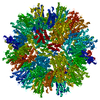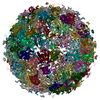+ Open data
Open data
- Basic information
Basic information
| Entry | Database: EMDB / ID: EMD-1158 | |||||||||
|---|---|---|---|---|---|---|---|---|---|---|
| Title | Hepatitis B small surface antigen particles are octahedral. | |||||||||
 Map data Map data | Electron density map of an octahedral small Hepatitis B surface antigen particle | |||||||||
 Sample Sample |
| |||||||||
| Biological species |   Hepatitis B virus Hepatitis B virus | |||||||||
| Method | single particle reconstruction / cryo EM / Resolution: 12.0 Å | |||||||||
 Authors Authors | Gilbert RJC / Beales L / Blond D / Simon MN / Lin BY / Chisari FV / Stuart DI / Rowlands DJ | |||||||||
 Citation Citation |  Journal: Proc Natl Acad Sci U S A / Year: 2005 Journal: Proc Natl Acad Sci U S A / Year: 2005Title: Hepatitis B small surface antigen particles are octahedral. Authors: Robert J C Gilbert / Lucy Beales / Donatienne Blond / Martha N Simon / Beth Y Lin / Francis V Chisari / David I Stuart / David J Rowlands /  Abstract: The infectious component of hepatitis B (HB) virus (HBV), the Dane particle, has a diameter of approximately 44 nm and consists of a double-layered capsid particle enclosing a circular, incomplete ...The infectious component of hepatitis B (HB) virus (HBV), the Dane particle, has a diameter of approximately 44 nm and consists of a double-layered capsid particle enclosing a circular, incomplete double-stranded DNA genome. The outer capsid layer is formed from the HB surface antigen (HBsAg) and lipid, whereas the inner layer is formed from the HB core Ag assembled into an icosahedral structure. During chronic infection HBsAg is expressed in large excess as noninfectious quasispherical particles and tubules with approximately 22-nm diameter. Here, we report cryo-EM reconstructions of spherical HBsAg particles at approximately 12-A resolution. We show that the particles possess different diameters and have separated them into two predominant populations, both of which have octahedral symmetry. Despite their differing diameters, the two forms of the particle have the same mass and are built through conformational switching of the same building block, a dimer of HBsAg. We propose that this conformational switching, combined with interactions with the underlying core, leads to the formation of HBV Dane particles of different sizes, dictated by the symmetry of the icosahedral core. | |||||||||
| History |
|
- Structure visualization
Structure visualization
| Movie |
 Movie viewer Movie viewer |
|---|---|
| Structure viewer | EM map:  SurfView SurfView Molmil Molmil Jmol/JSmol Jmol/JSmol |
| Supplemental images |
- Downloads & links
Downloads & links
-EMDB archive
| Map data |  emd_1158.map.gz emd_1158.map.gz | 7.4 MB |  EMDB map data format EMDB map data format | |
|---|---|---|---|---|
| Header (meta data) |  emd-1158-v30.xml emd-1158-v30.xml emd-1158.xml emd-1158.xml | 10.2 KB 10.2 KB | Display Display |  EMDB header EMDB header |
| Images |  1158.gif 1158.gif | 41.7 KB | ||
| Archive directory |  http://ftp.pdbj.org/pub/emdb/structures/EMD-1158 http://ftp.pdbj.org/pub/emdb/structures/EMD-1158 ftp://ftp.pdbj.org/pub/emdb/structures/EMD-1158 ftp://ftp.pdbj.org/pub/emdb/structures/EMD-1158 | HTTPS FTP |
-Validation report
| Summary document |  emd_1158_validation.pdf.gz emd_1158_validation.pdf.gz | 239 KB | Display |  EMDB validaton report EMDB validaton report |
|---|---|---|---|---|
| Full document |  emd_1158_full_validation.pdf.gz emd_1158_full_validation.pdf.gz | 238.2 KB | Display | |
| Data in XML |  emd_1158_validation.xml.gz emd_1158_validation.xml.gz | 5.7 KB | Display | |
| Arichive directory |  https://ftp.pdbj.org/pub/emdb/validation_reports/EMD-1158 https://ftp.pdbj.org/pub/emdb/validation_reports/EMD-1158 ftp://ftp.pdbj.org/pub/emdb/validation_reports/EMD-1158 ftp://ftp.pdbj.org/pub/emdb/validation_reports/EMD-1158 | HTTPS FTP |
-Related structure data
- Links
Links
| EMDB pages |  EMDB (EBI/PDBe) / EMDB (EBI/PDBe) /  EMDataResource EMDataResource |
|---|
- Map
Map
| File |  Download / File: emd_1158.map.gz / Format: CCP4 / Size: 7.8 MB / Type: IMAGE STORED AS FLOATING POINT NUMBER (4 BYTES) Download / File: emd_1158.map.gz / Format: CCP4 / Size: 7.8 MB / Type: IMAGE STORED AS FLOATING POINT NUMBER (4 BYTES) | ||||||||||||||||||||||||||||||||||||||||||||||||||||||||||||||||||||
|---|---|---|---|---|---|---|---|---|---|---|---|---|---|---|---|---|---|---|---|---|---|---|---|---|---|---|---|---|---|---|---|---|---|---|---|---|---|---|---|---|---|---|---|---|---|---|---|---|---|---|---|---|---|---|---|---|---|---|---|---|---|---|---|---|---|---|---|---|---|
| Annotation | Electron density map of an octahedral small Hepatitis B surface antigen particle | ||||||||||||||||||||||||||||||||||||||||||||||||||||||||||||||||||||
| Projections & slices | Image control
Images are generated by Spider. | ||||||||||||||||||||||||||||||||||||||||||||||||||||||||||||||||||||
| Voxel size | X=Y=Z: 2.7375 Å | ||||||||||||||||||||||||||||||||||||||||||||||||||||||||||||||||||||
| Density |
| ||||||||||||||||||||||||||||||||||||||||||||||||||||||||||||||||||||
| Symmetry | Space group: 1 | ||||||||||||||||||||||||||||||||||||||||||||||||||||||||||||||||||||
| Details | EMDB XML:
CCP4 map header:
| ||||||||||||||||||||||||||||||||||||||||||||||||||||||||||||||||||||
-Supplemental data
- Sample components
Sample components
-Entire : Hepatitis B small surface antigen
| Entire | Name: Hepatitis B small surface antigen |
|---|---|
| Components |
|
-Supramolecule #1000: Hepatitis B small surface antigen
| Supramolecule | Name: Hepatitis B small surface antigen / type: sample / ID: 1000 Details: The sample was a mixed population of smaller and larger particles; this is a map of the smaller kind Oligomeric state: An octahedral structure consisting of 48 / Number unique components: 1 |
|---|---|
| Molecular weight | Experimental: 2.18 MDa / Theoretical: 2.04 MDa Method: Volumetrically, also by STEM and fitting of atomic models |
-Macromolecule #1: surface antigen
| Macromolecule | Name: surface antigen / type: protein_or_peptide / ID: 1 / Name.synonym: sAg / Details: 48 sAg proteins compose the particle reconstructed / Number of copies: 48 / Oligomeric state: 48 copies obeying octahedral symmetry / Recombinant expression: Yes |
|---|---|
| Source (natural) | Organism:   Hepatitis B virus / Tissue: Mouse serum Hepatitis B virus / Tissue: Mouse serum |
| Molecular weight | Experimental: 24 KDa / Theoretical: 24 KDa |
| Recombinant expression | Organism:  |
-Experimental details
-Structure determination
| Method | cryo EM |
|---|---|
 Processing Processing | single particle reconstruction |
| Aggregation state | particle |
- Sample preparation
Sample preparation
| Concentration | 0.3 mg/mL |
|---|---|
| Buffer | pH: 7.2 / Details: PBS |
| Grid | Details: 300 mesh copper grid bearing holey carbon film |
| Vitrification | Cryogen name: ETHANE / Chamber temperature: 20 K / Instrument: HOMEMADE PLUNGER / Details: Vitrification instrument: Simple guillotone / Method: Blot until grid draws away from paper |
- Electron microscopy
Electron microscopy
| Microscope | FEI/PHILIPS CM200FEG |
|---|---|
| Temperature | Average: 100 K |
| Alignment procedure | Legacy - Astigmatism: Astigmatism corrected at 135,000 magnification |
| Date | Jun 1, 2000 |
| Image recording | Category: FILM / Film or detector model: KODAK SO-163 FILM / Digitization - Scanner: OTHER / Digitization - Sampling interval: 8.33 µm / Number real images: 17 / Average electron dose: 2 e/Å2 / Od range: 5 / Bits/pixel: 8 |
| Electron beam | Acceleration voltage: 200 kV / Electron source:  FIELD EMISSION GUN FIELD EMISSION GUN |
| Electron optics | Illumination mode: FLOOD BEAM / Imaging mode: BRIGHT FIELD / Cs: 2 mm / Nominal defocus max: 7.21 µm / Nominal defocus min: 1.79 µm / Nominal magnification: 38000 |
| Sample stage | Specimen holder: Eucentric / Specimen holder model: GATAN LIQUID NITROGEN |
- Image processing
Image processing
| Details | The particles were selected using Ximdisp |
|---|---|
| CTF correction | Details: by micrograph |
| Final reconstruction | Applied symmetry - Point group: O (octahedral) / Algorithm: OTHER / Resolution.type: BY AUTHOR / Resolution: 12.0 Å / Resolution method: OTHER / Software - Name: IMAGIC, FREALIGN and SPIDER Details: Single particles were reconstructed in IMAGIC using D2 symmetry and then in FREALIGN using tetrahedral symmetry. Maps were shown to in fact have octahedral symmetry. Reconstruction was ...Details: Single particles were reconstructed in IMAGIC using D2 symmetry and then in FREALIGN using tetrahedral symmetry. Maps were shown to in fact have octahedral symmetry. Reconstruction was iterative and has symmetry determination and size fractionation coupled. Number images used: 911 |
| Final angle assignment | Details: SPIDER |
 Movie
Movie Controller
Controller









 Y (Sec.)
Y (Sec.) X (Row.)
X (Row.) Z (Col.)
Z (Col.)





















